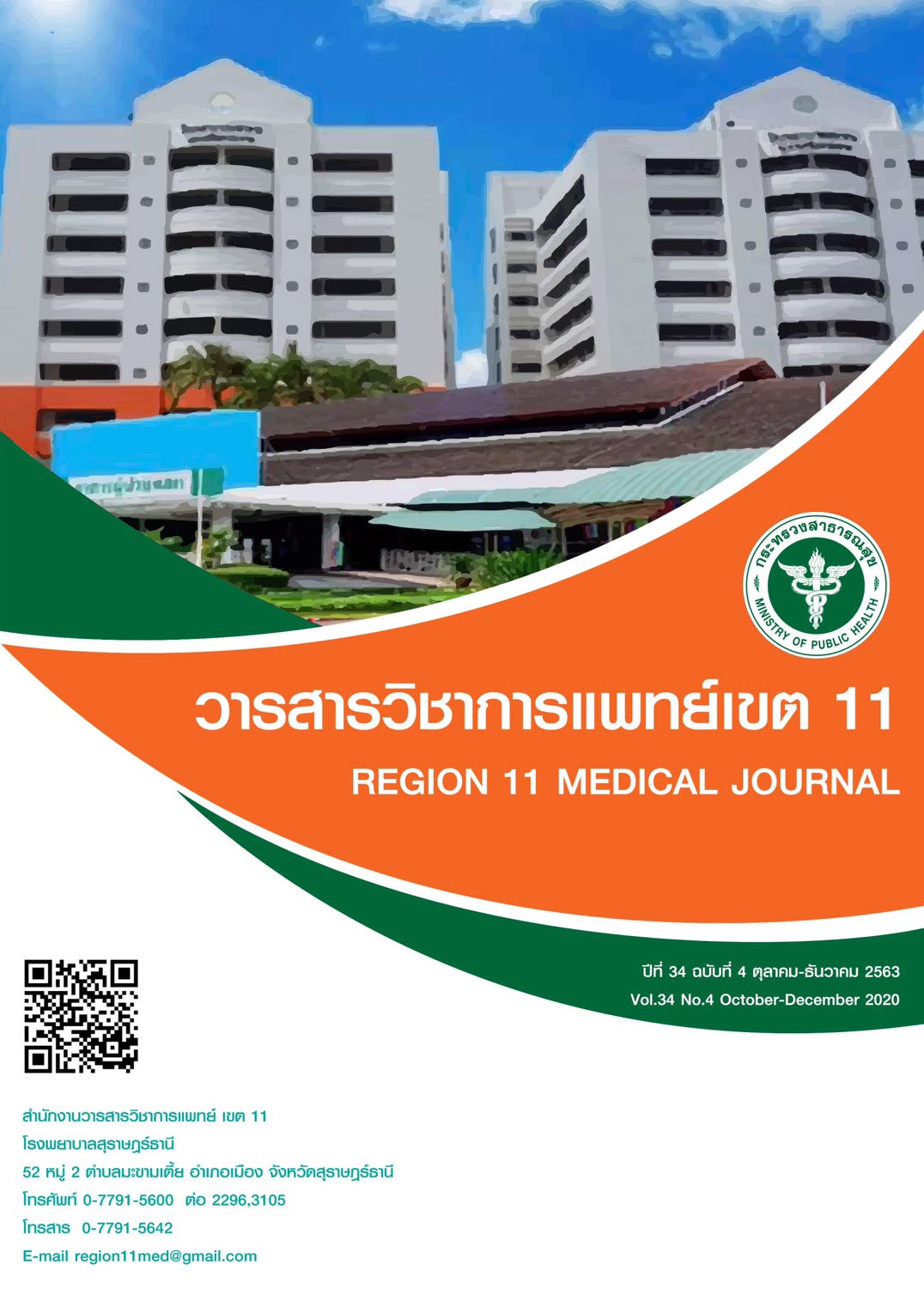การศึกษาอุบัติการณ์ และปัจจัยของผู้ป่วยกลุ่มความเสี่ยงต่ำ (ASA class 1 และ 2) ในการตรวจพบความผิดปกติของผลตรวจวิเคราะห์ในเลือด ภาพถ่ายรังสีปอดและคลื่นไฟฟ้าหัวใจ ก่อนมารับการระงับความรู้สึก
คำสำคัญ:
การตรวจวิเคราะห์ก่อนระงับความรู้สึก, ผู้ป่วยกลุ่มความเสี่ยงต่ำ, อุบัติการณ์บทคัดย่อ
ที่มา: การส่งตรวจวิเคราะห์ในเลือด ภาพถ่ายรังสีปอดและคลื่นไฟฟ้าหัวใจเป็นขั้นตอนหนึ่งของการประเมินสภาพผู้ป่วยก่อนที่จะเข้ารับการผ่าตัดหรือระงับความรู้สึก ในปัจจุบันกลุ่มผู้ป่วยความเสี่ยงต่ำมีอัตราการเข้ารับการผ่าตัดหรือระงับความรู้สึกที่เพิ่มขึ้น และการส่งตรวจนั้นทำได้ง่ายและสะดวกมากขึ้น จึงอาจทำให้มีการส่งตรวจที่มากเกินความจำเป็น
วัตถุประสงค์: เพื่อค้นหาอุบัติการณ์และปัจจัยเสี่ยงที่สัมพันธ์กับผลตรวจที่ผิดปกติในผู้ป่วยกลุ่มความเสี่ยงต่ำ
วิธีการ: เป็นการศึกษาแบบ cross-sectional study ในผู้ป่วยกลุ่ม ASA class 1 และ 2 ที่มารับการระงับความรู้สึกตั้งแต่เดือนตุลาคม 2562 ถึงเดือนธันวาคม 2562 เก็บข้อมูลจากใบบันทึกวิสัญญีและฐานข้อมูลโรงพยาบาล วิเคราะห์ผลใช้โปรแกรม SPSS 21 หาอุบัติการณ์ของการส่งตรวจและความผิดปกติของผลตรวจ และวิเคราะห์หาปัจจัยที่มีความสัมพันธ์กับผลการตรวจที่ผิดปกติ โดยใช้สถิติ chi-square และ multiple logistic regression ที่มีนัยสำคัญ p-value<0.05
ผลการศึกษา: มีผู้ป่วย 1,404 รายที่เข้าเกณฑ์การศึกษา ได้ส่งตรวจหาความอัดแน่นเม็ดเลือด (hematocrit: Hct) มากที่สุดคิดเป็นร้อยละ 98.3 และการส่งตรวจการทำงานของตับ (liver function test: LFT) มีอัตราส่วนของการพบความผิดปกติมากที่สุด คิดเป็นร้อยละ 12.0 กลุ่มผู้ป่วย ASA class 2 ผลตรวจผิดปกติมากกว่าอีกกลุ่มอย่างมีนัยสำคัญ ปัจจัยที่มีความสัมพันธ์กับความผิดปกติของ Hct และภาพรังสีปอด (chest radiography: CXR) ได้แก่ อายุมากกว่า 45 ปี ASA class 2 และมีโรคร่วมตั้งแต่ 1 โรคขึ้นไป ส่วนผู้ป่วยที่มีโรคร่วมตั้งแต่ 2 โรคขึ้นไป เป็นปัจจัยที่สัมพันธ์กับคลื่นไฟฟ้าหัวใจ (electrocardiogram: EKG)
ที่ผิดปกติ
สรุป: ผู้ป่วยที่อายุมากกว่า 45 ปีขึ้นไป ASA class 2 หรือมีโรคร่วมตั้งแต่ 1 โรคขึ้นไปควรจะได้รับการส่งตรวจเพิ่มเติมก่อนระงับความรู้สึก และการส่งตรวจ EKG ให้พิจารณาทำในผู้ป่วยที่มีโรคร่วมตั้งแต่ 2 โรคขึ้นไป
เอกสารอ้างอิง
Abouleish AE, Leib ML, Cohen NH. ASA provides examples to each ASA Physical Status Class. ASA Newsletter. 2015;79(6):38-49.
Fleisher LA, Fleischmann KE, Auerbach AD, Barnason SA, Beckman JA, Bozkurt B, et al. 2014 ACC/AHA guideline on perioperative cardiovascular evaluation and management of patients undergoing noncardiac surgery: a report of the American College of Cardiology/American Heart Association Task Force on practice guidelines. Circulation. 2014;130(24):e278-e333.
Soares DdS, Brandão RRM, Mourão MRN, Azevedo VLFd, Figueiredo AV, Trindade ES. Relevance of routine testing in low-risk patients undergoing minor and medium surgical procedures. Revista Brasileira De Anestesiologia. 2013;63(2):197-201.
Johansson T, Fritsch G, Flamm M, Hansbauer B, Bachofner N, Mann E, et al. Effectiveness of non-cardiac preoperative testing in non-cardiac elective surgery: a systematic review. British journal of anaesthesia. 2013;110(6):926-39.
Turnbull JM, Buck C. The value of preoperative screening investigations in otherwise healthy individuals. Archives of internal medicine. 1987;147(6):1101-5.
Rees A, Roberts C, Bligh A, Evans K. Routine preoperative chest radiography in non-cardiopulmonary surgery. Br Med J. 1976;1(6021):1333-5.
Seymour DG, Pringle R, Shaw JW. The role of the routine pre-operative chest X-ray in the elderly general surgical patient. Postgraduate Medical Journal. 1982;58(686):741-5.
Rucker L, Frye EB, Staten MA. Usefulness of screening chest roentgenograms in preoperative patients. Jama. 1983;250(23):3209-11.
Bouillot J, Fingerhut A, Paquet J, Hay J, Coggia M. Are routine preoperative chest radiographs useful in general surgery? A prospective, multicentre study in 3959 patients. Association des Chirurgiens de l'Assistance Publique pour les Evaluations médicales. The European journal of surgery= Acta chirurgica. 1996;162(8):597-604.
Silvestri L, Maffessanti M, Gregori D, Berlot G, Gullo A. Usefulness of routine pre‐operative chest radiography for anaesthetic management: a prospective multicentre pilot study. European journal of anaesthesiology. 1999;16(11):749-60.
Kerr I. The preoperative chest X-ray. British Journal of anaesthesia. 1974;46(8):558-63.
Noordzij PG, Boersma E, Bax JJ, Feringa HH, Schreiner F, Schouten O, et al. Prognostic value of routine preoperative electrocardiography in patients undergoing noncardiac surgery. The American journal of cardiology. 2006;97(7):1103-6.
Bochicchio GV, Laura S, Manjari J, Kelly B, Scalea TM. Admission preoperative glucose is predictive of morbidity and mortality in trauma patients who require immediate operative intervention. The American surgeon. 2005;71(2):171-4.
Munro J, Booth A, Nicholl J. Routine preoperative testing: a systematic review of the evidence. Health Technology Assessment (Winchester, England). 1997;1(12):1-62.






